Child Maintenance Service statistics: data to June 2020 (experimental)
Published 30 September 2020
Applies to England, Scotland and Wales
The latest release of these statistics can be found in the collection of Child Maintenance Service statistics.
This release of statistics is on the Child Maintenance Service between January 2015 and June 2020. The release includes revisions to previously published statistics.
The next release is planned for December 2020.
1. Introduction
The Child Maintenance Service was introduced in December 2012 as part of the government’s Child Maintenance reforms. It replaced the Child Support Agency (CSA) and is for separated parents who cannot arrange child maintenance between themselves.
Direct Pay is where the Child Maintenance Service calculates the amount of maintenance to be paid and parents arrange the payments between themselves.
If parents cannot do this or they do not pay what was agreed, then the Child Maintenance Service can collect and manage the payments between the parents. This is the Collect and Pay service.
The Child Maintenance Service has a range of enforcement actions it can use if the Paying Parent refuses to pay their child maintenance.
Effect of COVID-19
This publication covers data up to the end of June 2020. During this period, the Child Maintenance Service was affected by the COVID-19 outbreak and the resultant changes to the Department’s operational priorities. In the UK, the lockdown began on 23 March 2020.
2. Main stories
741,200 children are covered by Child Maintenance Service arrangements.
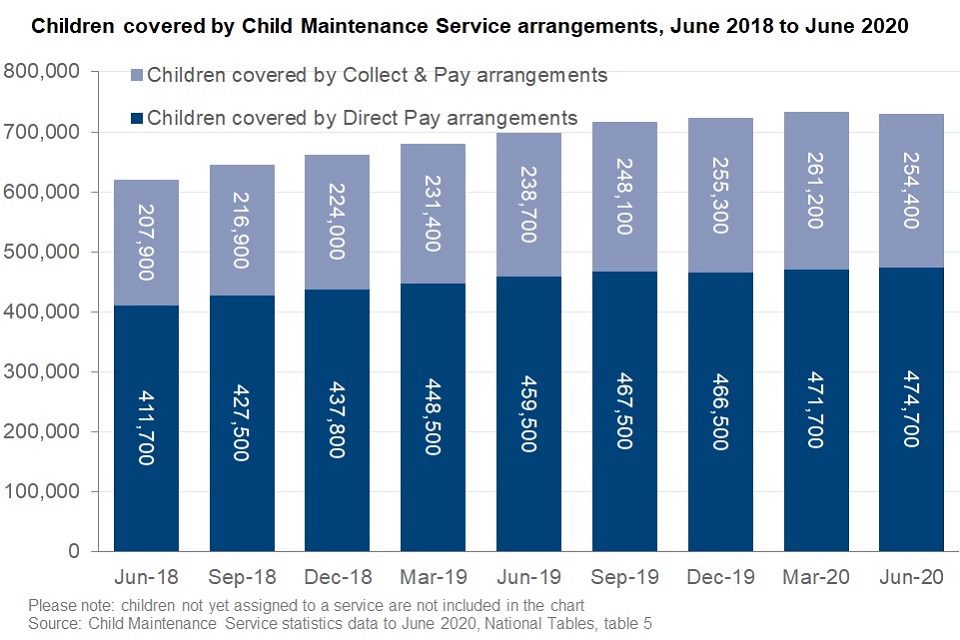
There are:
- 474,700 children covered through Direct Pay arrangements
- 254,400 children covered through the Collect and Pay Service
- 12,100 children not yet assigned to a service
The number of children covered by the Child Maintenance service has increased by 3,600 since the previous quarter. The number of children has increased steadily over the last two years.
Compliance on the Collect and Pay service is at 74%.
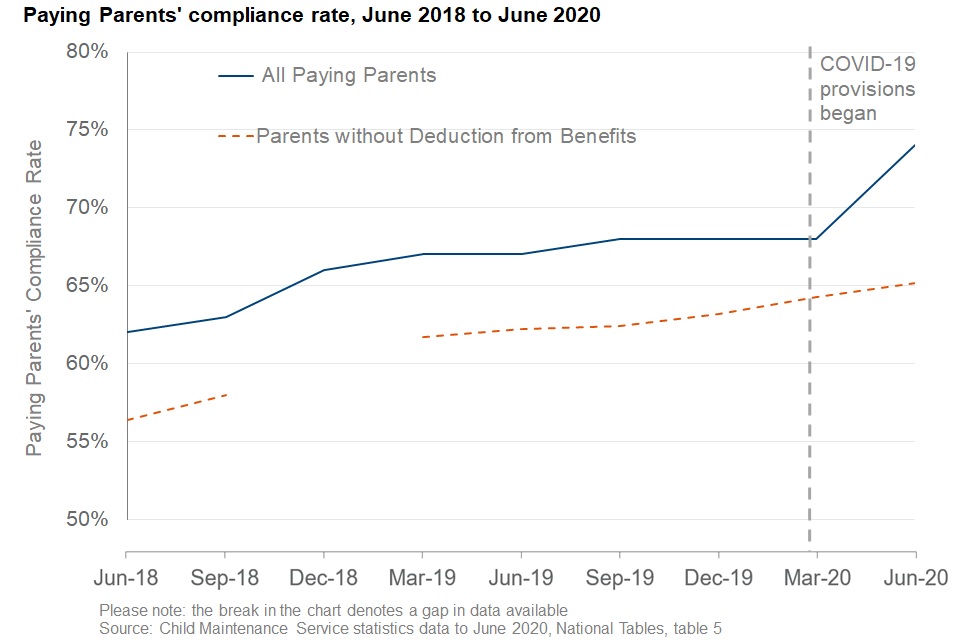
74% of parents due to pay child maintenance through the Collect and Pay service paid some maintenance in the quarter ending June 2020. This is an increase from 68% in the quarter ending March 2020 but should be viewed with caution. The compliance rate has been inflated this quarter as a result of the COVID-19 pandemic. Between 10 April and 9 May 2020, all deductions from Universal Credit (UC) were temporarily paused and the Government paid all child maintenance liabilities for parents paying via deductions from UC. This resulted in a higher than usual rate of compliance for this group. In addition, there has been an increased movement of people onto benefits. Therefore, more parents are paying via Deduction from Benefits; these individuals are now more likely contribute some maintenance, as deductions are made automatically.
This means that the compliance rate for this quarter is not directly comparable to previous quarters. In order to show the movement in compliance rates for groups not affected by these issues, we have temporarily included the compliance rate excluding Deduction from Benefits cases within our data. The Deduction from Benefit cases typically account for 21% to 24% of all Paying Parents, for June 2020 this has increased to 39% due to the COVID-19 outbreak.
The Collect & Pay service is largely composed of individuals that transferred from the Direct Pay service, after failing to pay their liabilities.
3. What you need to know
Child maintenance is financial support between separated parents to help with the everyday costs of looking after children.
If they agree, separated parents can arrange child maintenance themselves. This is called a ‘family-based arrangement’ and is a private way to sort out child maintenance. Parents arrange everything themselves and no-one else has to be involved.
The Child Maintenance Service, which replaced the Child Support Agency (CSA), is for when parents cannot agree to a family-based arrangement. Parents wishing to use the Child Maintenance Service must first contact Child Maintenance Options (CM Options).
CM Options is a free service that provides impartial information and support to help separated parents make decisions about their child maintenance arrangements.
Read information on child maintenance arrangements made after speaking to CM Options.
Definitions
Receiving Parent
The Receiving Parent has the main day-to-day care of the children and receives the child maintenance.
Paying Parent
The Paying Parent does not have the main day-to-day care of the children and pays child maintenance.
Children covered
Children covered is the number of children for whom the Paying Parent has a child maintenance arrangement.
Compliance
Compliance is where parents using the Collect and Pay service have paid some child maintenance in the last three months.
See the Background Information document for more details.
4. Applications to the Child Maintenance Service
Parents who want to apply to the Child Maintenance Service must pay a £20 application fee. Parents do not have to pay this if they:
- have been a victim of domestic abuse
- declare their child has been the victim of abuse
- are under 19 years of age
Some applications to the Child Maintenance Service are from parents who previously had an arrangement with the Child Support Agency. All Child Support Agency cases with an ongoing liability were closed by December 2018, and parents were encouraged to make a new family-based arrangement or an arrangement through the Child Maintenance Service. However, the Child Maintenance Service may still receive applications from such parents, as they may have had a family-based arrangement in the interim.
The number of new arrangements joining the Child Maintenance Service has decreased this quarter.
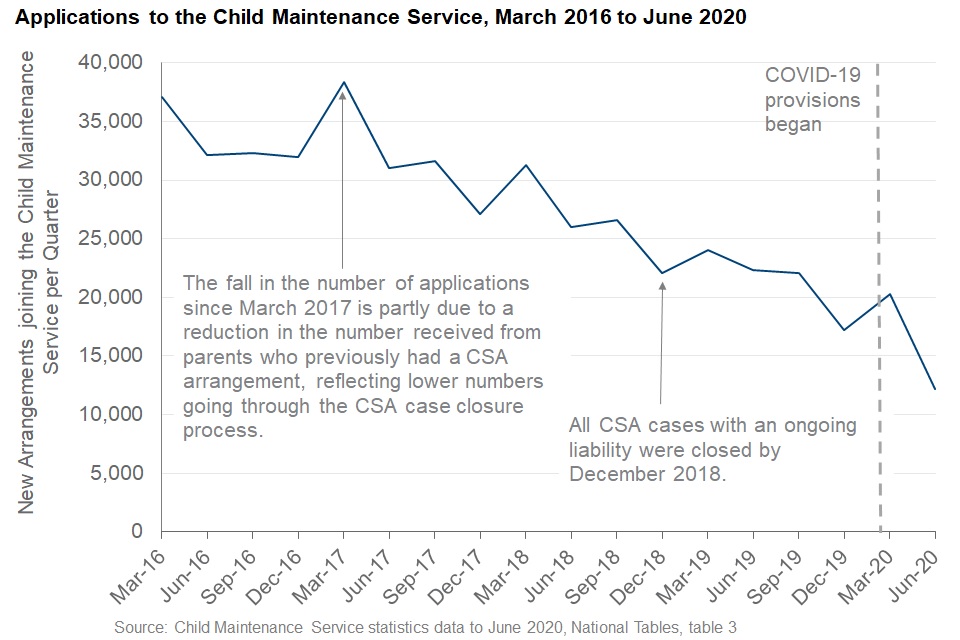
Throughout 2019, the rate of applications joining the service continued to decline in line with the downward trend. In the last quarter, ending June 2020, the intake decreased to 12,200.
At the end of June 2020, the Child Maintenance Service was managing 518,800 arrangements for 486,800 Paying Parents. This is a 6% increase to the number of arrangements since the end of June 2019.
See tables 1 to 3 and 7 of the national tables published with this release for more information.
See Stat-Xplore for more information on arrangements.
5. Composition of cases on the Child Maintenance Service
When a parent makes an application to the Child Maintenance Service, they will be told how much child maintenance should be paid.
Some parents will then arrange the payments between themselves: this service is known as Direct Pay where the CMS calculates the amount of maintenance that should be paid and parents make their own arrangements for payments. The CMS simply provides the calculation and no further use of the service is required. Direct Pay can be chosen by either parent with the other’s agreement. A £20 application fee is charged for this service (unless waived). Neither parent pays collections fees under Direct Pay.
Parents are issued a text message 3 months after they set up a Direct Pay arrangement, and at each annual review, to check that the arrangement is still meeting their requirements.
If parents cannot arrange payments between themselves, or if the Paying Parent does not keep up with the payments, the receiving parent can ask the Child Maintenance Service to switch the case to the Collect and Pay service.
Under the Collect and Pay service, the CMS calculates the amount of maintenance, including recovery of unpaid maintenance that built up under the Direct Pay service, then collects the payment from the Paying Parent and pays it to the Receiving Parent.
There are ongoing collection charges for use of the Collect and Pay service, payable by both the Paying Parent (20% on top of the maintenance amount), and the Receiving Parent (4% taken out of the amount of maintenance).
Non-compliance under the Collect and Pay service could lead to the use of enforcement powers.
Most new applicants chose to start on Direct Pay.
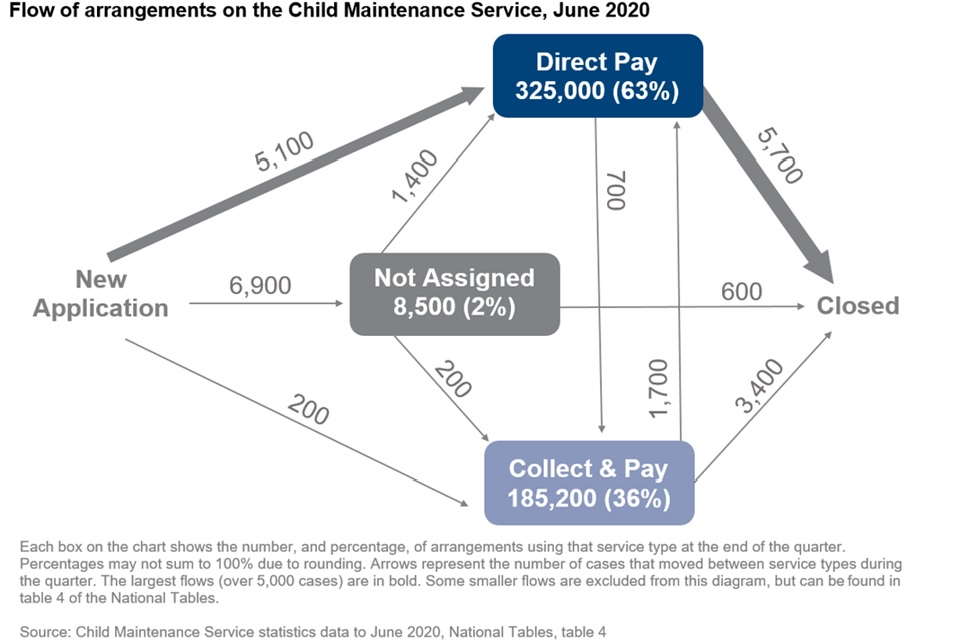
The flow of arrangements around the Child Maintenance Service in the quarter June 2020 showed:
- most new applicants choose to start on Direct Pay: 5,100 new applicants joined Direct Pay during the quarter ending June 2020
- 63% of all Child Maintenance Service arrangements use Direct Pay, with 36% using Collect and Pay
- more parents moved from Collect and Pay to Direct Pay than the other way around: 1,700 parents switched to Direct Pay during this quarter
- the number of arrangements increased by 3,100 during this quarter
- the number of arrangements not yet assigned to a service is up to 8,500 from 3,500 in the previous quarter ending March 2020
Arrangements may not be assigned to a service type for a short period following application. In response to the COVID-19 outbreak, outstanding work and resources, including the progress of new applications, needed to be re-prioritised, resulting in an increase in the number of arrangements not yet assigned to a service type and a reduction in the number of service type changes.
See table 4 of the national tables published with this release for more information.
See Stat-Xplore for more information on arrangements.
6. Children covered by the Child Maintenance Service
The number of children covered by Direct Pay arrangements continues to steadily rise.

At the end of June 2020:
- 474,700 children were covered by 325,045 Direct Pay arrangements
- 254,400 children were covered by 185,243 arrangements through the Collect and Pay service
- 160,000 of these children were covered by 112,400 Collect and Pay arrangements where the Paying Parent paid some maintenance during the quarter
- the number of children has increased steadily over the last 2 years
64% of all children covered by Child Maintenance Service are covered through Direct Pay arrangements, with 22% covered by Collect and Pay arrangements for which some maintenance was paid in the quarter. These proportions have changed little over the last 12 months (66% and 19% respectively in June 2019).
See table 5 of the national tables published with this release for more information.
7. Paying Parents and the Collect and Pay service
This includes Paying Parents transferred from the Direct Pay service because they have failed to keep up with payments.
The compliance rate of Paying Parents continues to rise.
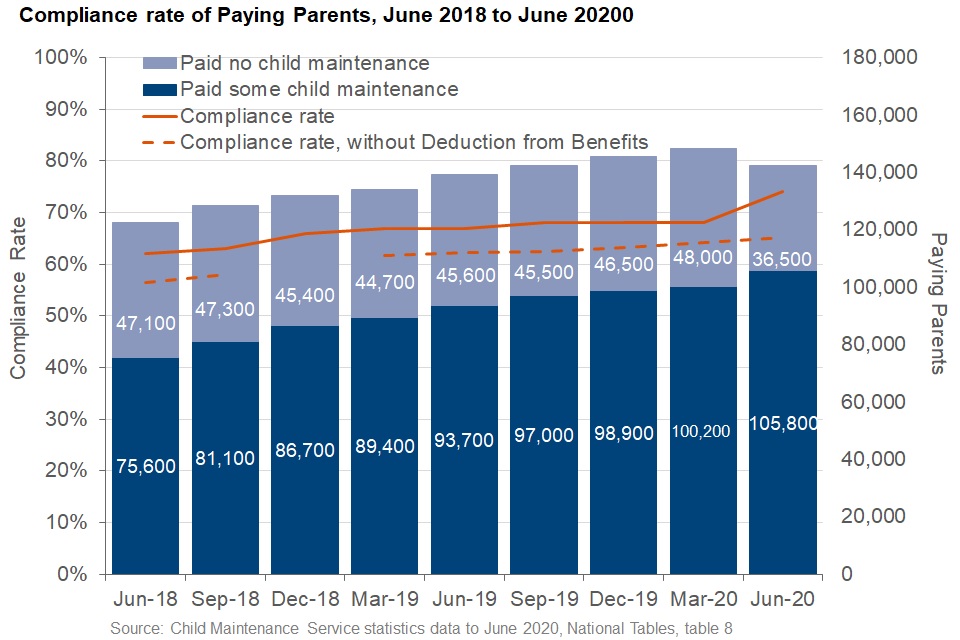
In the quarter ending June 2020, 105,800 Paying Parents paid some of their child maintenance through the Collect and Pay service. This was 74% of all Paying Parents due to pay child maintenance through the Collect & Pay service in that quarter. This is an increase from 68% in the quarter ending March 2020 but should be viewed with caution. The compliance rate has been inflated this quarter as a result of the COVID-19 pandemic. Between 10 April and 9 May 2020, all deductions from Universal Credit (UC) were temporarily paused and the Government paid all child maintenance liabilities for parents paying via deductions from UC. This resulted in a higher than usual rate of compliance for this group. In addition, there has been an increased movement of people onto benefits. Therefore, more parents are paying via Deduction from Benefits; these individuals are now more likely contribute some maintenance, as deductions are made automatically.
This means that the compliance rate for this quarter is not directly comparable to previous quarters. In order to show the movement in compliance rates for groups not affected by these issues, we have temporarily included the compliance rate excluding Deduction from Benefits cases within our data. The Deduction from Benefit cases typically account for 21% to 24% of all Paying Parents, for June 2020 this has increased to 39% due to the COVID-19 outbreak.
In addition, the number of Paying Parents due to pay through Collect and Pay is substantially lower this quarter this should be seen in context with an increase in the number of Paying Parents with nil liability as a result of the COVID-19 outbreak.
See table 8 of the national tables published with this release for more information.
8. Child Maintenance due and paid
The Child Maintenance Service monitors payments made through the Collect and Pay service and can take enforcement action where necessary.
Parents on Direct Pay with unpaid maintenance owed will first have to transfer to Collect and Pay before the Child Maintenance Service can take any action. This means the Collect and Pay service consists of a subset of Paying Parents who are less likely to pay.
Child Maintenance due to be paid through the Collect & Pay service has dropped from the previous quarter.

During the quarter ending June 2020, £252.3 million Child Maintenance was due to be paid.
£238.4 million was paid through the Collect and Pay service or due to be paid through Direct Pay arrangements:
- £196.7 million due to be paid through Direct Pay arrangements
- £41.7 million paid through the Collect and Pay service
This quarter the amount of money due to be paid through Collect and Pay is substantially lower than the previous quarter, this should be seen in context with a reduction in Paying Parent income as a result of the COVID-19 outbreak.
Over the long term, the amount of money due to be paid through the Child Maintenance Service has been rising as the number of parents using the service has increased.
£13.9 million of maintenance due to be paid through the Collect and Pay service in the quarter ending June 2020 was not paid.
Since 2012, when the Child Maintenance Service began, £361.6 million in unpaid maintenance is owed through the Collect and Pay service. This amounts to 10% of all maintenance due to be paid since the start of the service and includes unpaid maintenance transferred from Direct Pay to Collect and Pay.
See tables 9 and 10 of the national tables published with this release for more information.
9. Enforcement
When a payment is missed, the Child Maintenance Service contacts the Paying Parent to arrange a recovery of what is owed or to make clear the actions that may be pursued in the absence of a payment.
For parents on Collect and Pay, enforcement is automatically pursued on their behalf.
For parents on Direct Pay (where the receiving parent asks the Child Maintenance Service to take action) the arrangement is first switched to the Collect and Pay service before any enforcement action can commence.
The Child Maintenance Service can collect unpaid child maintenance in 3 major ways:
-
deduction from earnings order or request – money is recovered from the paying parent’s earnings via their employer, who will be instructed on the amount to deduct
-
deduction order – money is deducted directly from the paying parent’s bank or building society account
-
courts – a paying parent can be taken to court over unpaid maintenance
The courts can grant liability orders, which allow further action to be taken, such as referral to enforcement agents, who can seize goods and sell them to cover any unpaid maintenance and costs.
Where the paying parent is a homeowner, courts may grant a charging order against the property, which prevents any sale without repayment of the outstanding amount.
Ultimately, the court may grant an order for sale which forces the sale of the property. If these methods are unsuccessful, the Child Maintenance Service may apply for the courts to:
-
disqualify the parent from holding or obtaining a driving licence
-
disqualify the parent from holding or obtaining a passport
-
send the parent to prison
The number of Enforcement Actions taking place this quarter has dropped since last quarter.
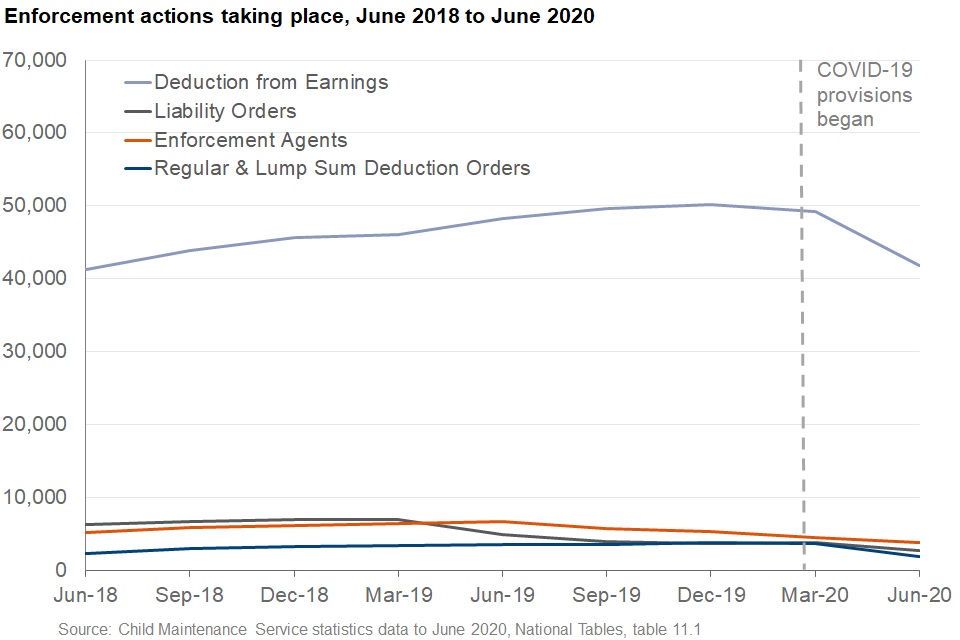
At the end of June 2020:
- 41,800 deductions from earnings orders and requests were in place, down from 49,200 at the end of March 2020
- 2,700 liability orders were in process
- 3,800 enforcement agent referrals were in process
- 1,800 regular and lump sum deduction orders were in process
During the quarter ending June 2020, the Child Maintenance Service was affected by the COVID-19 outbreak and the resultant changes to the Department’s operational priorities and staffing resources. Enforcement action also requires substantial resource from third parties, who may have been similarly affected. Therefore, for the quarter ending June 2020, the initiation of any new enforcement action was suspended.
See tables 11.1 and 11.2 of the national tables published with this release for more information.
10. About these statistics
Comparisons
Comparisons between these statistics on the Child Maintenance Service and statistics on the Child Support Agency should not be made as the 2 services have different aims and cover different groups.
The government’s changes to the child maintenance system in 2012 were designed to encourage parents to work together to provide for their children. Child Maintenance Options was created to support parents to set up collaborative, family-based arrangement. The Child Maintenance Service was intended for those parents who cannot make family-based arrangements.
Rounding
Figures contained within this publication are rounded to the nearest hundred, percent, or £100,000. Percentages are calculated prior to rounding.
These statistics have been developed using guidelines set out by the UK Statistics Authority.
Changes made to this publication
Paying Parent Compliance
74% of parents due to pay child maintenance through the Collect and Pay service paid some maintenance in the quarter ending June 2020. This is an increase from 68% in the quarter ending March 2020 but should be viewed with caution. The compliance rate has been inflated this quarter as a result of the COVID-19 pandemic. Between 10 April and 9 May 2020, all deductions from Universal Credit (UC) were temporarily paused and the Government paid all child maintenance liabilities for parents paying via deductions from UC. This resulted in a higher than usual rate of compliance for this group. In addition, there has been an increased movement of people onto benefits. Therefore, more parents are paying via Deduction from Benefits; these individuals are now more likely contribute some maintenance, as deductions are made automatically.
This means that the compliance rate for this quarter is not directly comparable to previous quarters. In order to show the movement in compliance rates for groups not affected by these issues, we have temporarily included the compliance rate excluding Deduction from Benefits cases within our data. The Deduction from Benefit cases typically account for 21% to 24% of all Paying Parents, for June 2020 this has increased to 39% due to the COVID-19 outbreak.
Planned changes
We are hoping to move more of our regular statistics to the StatXplore platform in the near future.
Where to find out more
Read previous releases of these statistics.
Read information and statistics on family-based arrangements.
Authors: Amy Grant and James Kerr
Lead statistician: Juwaria Rahman
Feedback is welcome, send comments to: cm.analysis.research@dwp.gov.uk
ISBN: 978-1-78659-275-0
